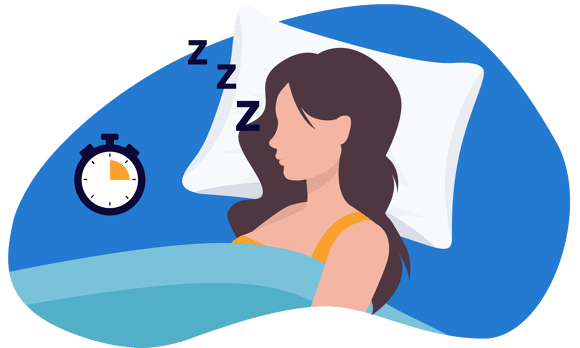How many pillows should you sleep with?
Selecting the right number of pillows depends on individual needs, body type, and sleeping position.
Comfort, spinal alignment, and health conditions influence how many pillows work best for restful sleep.
Here’s a quick overview.
How many pillows should adults sleep with?
Most adults benefit from using one to two pillows.
- One pillow provides adequate neck support for back sleepers, maintaining the natural curve of the spine.
- Side sleepers often require two pillows: one to support the head and neck, and another between the knees to reduce pressure on the hips and lower back.
Using too many pillows can actually lead to neck stiffness or poor spinal alignment.
But ultimately, comfort and correct posture should guide your pillow choice rather than habit or aesthetics.

Since we know how difficult it can be to find the right pillow loft, we're always big fans of adjustable pillows, like the Emma Premium pillow and the Simba Hybrid pillow.
How many pillows should children and teenagers sleep with?
Children and teenagers generally need fewer pillows.
A single, soft pillow usually suffices to support their smaller heads and developing spines.
Multiple pillows or pillows that are too high can actually lead to neck misalignment, negatively affecting sleep quality. 😧
For very small children, opting for a specialised toddler pillow may be a good idea.

As children grow and transition in sleeping positions, pillow requirements may change.
Parents should then observe comfort and posture to find the right fit rather than rely on fixed rules.
How many pillows should the elderly sleep with?
Elderly sleepers often experience changes in muscle tone and joint flexibility, which affect pillow needs.
One or two pillows are often best, depending on sleep position and any health issues such as arthritis or respiratory problems.
A firmer pillow can provide necessary neck support, but softness is also important to reduce pressure points.
Elevating the head with an additional pillow can help with breathing or acid reflux symptoms in some elderly individuals.
Ultimately, both comfort and health considerations should lead pillow choice for the elderly.
What influences how many pillows you should sleep with?
The ideal number of pillows depends on various physical and health-related factors.
Comfort, support, and alignment are key considerations that vary between individuals.
Preferred sleep position
The way someone sleeps strongly affects how many pillows they should use.
- For back sleepers, one medium-firm pillow is often enough to support the neck without causing strain. Using more pillows may push the head too far forward, disrupting spinal alignment.
- Stomach sleepers usually need fewer pillows, a very thin pillow, or even no pillow at all, to avoid arching the neck backward. Using multiple pillows can increase strain on the neck and shoulders, leading to discomfort.
- Side sleepers generally benefit from one to two pillows. One pillow supports the head and neck, while an additional knee pillow can help maintain hip alignment.
Too few pillows may cause neck discomfort, while too many can bend the neck unnaturally.
Are two pillows bad for your neck?
Using two pillows under the head can tilt the neck forward, compressing cervical joints and straining muscles.
Physiotherapists have labelled this habit "two‑pillow syndrome [1]", linking it to morning stiffness and poor posture.
Yet, two pillows can be helpful when they serve different roles – for instance, one under the head and one between the knees for side sleepers, or a second pillow under the knees for back sleepers to ease lower‑back pressure.
Personal health considerations
Certain health conditions influence pillow usage.
For example, individuals with acid reflux [2] or respiratory issues may require an elevated head position, often achieved by stacking two or more pillows or using a wedge pillow.

People with neck or back pain should choose the number of pillows that support natural spinal curvature without causing pressure points.
Sometimes, using a specialised cervical pillow in place of multiple standard pillows is more effective.
Allergies also impact pillow choice: Hypoallergenic pillows may be preferred, and fewer pillows can reduce dust mite accumulation, improving air quality during sleep.
Should I sleep without a pillow?
Stomach sleepers may feel better with no pillow or a very flat option, as this helps keep the neck in neutral alignment and reduces lower‑back arching.
Back and side sleepers usually need at least one pillow to fill the gap between mattress and head.
Trying to go pillow‑free? Start with a slim pillow and assess comfort over a few nights.
If neck pain or numb arms develop, reintroduce a low‑loft pillow.
Body type and frame
A person’s body shape and size affect pillow requirements.
- Those with broader shoulders often need thicker or firmer pillows to fill the gap between the head and mattress when sleeping on their side.
- Smaller or lighter-framed individuals may find a single, softer pillow provides adequate support without elevating the head too much. Over-elevating can cause strain.
Height also plays a role: Taller individuals might need longer pillows, like full-body pillows, or specific arrangements to maintain spinal alignment, especially in side sleeping positions.
Adjusting pillow quantity and type helps accommodate varying body structures.
Selecting the right pillows and arrangements
Choosing pillows that provide proper support and comfort is crucial for restful sleep.
The arrangement and care of pillows also affect their effectiveness and longevity.
Choosing suitable pillow types
The pillow type should align with the sleeper’s position and personal preferences.
Materials such as memory foam, latex, or feather offer different support and breathability.
- Memory foam pillows adapt to the head’s shape but can retain heat
- Feather pillows provide softness and adjustability but need regular fluffing
Height and firmness affect the alignment of the head, neck, and spine.
Pillow loft and firmness decoded
What is pillow loft?
This refers to a pillow’s height when lying flat.
- Low loft: Under 8 cm, well-suited to stomach sleepers
- Medium loft: 8 - 13 cm, which is ideal for back sleepers
- High loft: Over 13 cm, which is often best for side sleepers or broader shoulders
It’s also important to match a pillow's firmness to one's sleep position:
- Soft pillows allow gentle contouring and are good for stomach or petite sleepers
- Medium pillows balance give and support, and are popular with back sleepers
- Firm pillows resist deep sinking and are preferred by side sleepers or heavier frames
Choosing the right combination of loft and firmness is more important than piling up extra pillows.
Special pillow setups for specific needs
Certain situations require adjustments in the number and placement of pillows for optimal comfort and health.
These needs often depend on individual physical conditions or stages of life, where standard pillow use may not be sufficient.
Pregnancy and maternity support
Pregnant individuals often benefit from using multiple pillows to support the body.
A common recommendation is to use one pillow beneath the head, plus additional pillows to support the abdomen and between the knees.
This helps maintain spinal alignment and reduces pressure on the lower back.
Side sleeping, particularly on the left side, is advised during pregnancy, and placing a firm pillow between the legs can ease hip and back strain.
Another pillow behind the back can prevent rolling onto the back during sleep, which is often uncomfortable or risky in later pregnancy stages.
Using pillows designed specifically for maternity, such as full-body pillows, like the Simba Body Pillow, or wedge-shaped or V-shaped pillows, can also improve sleep quality by offering customised support.
Snoring and respiratory issues
People with specific medical conditions often require tailored pillow setups.
For example, individuals with acid reflux benefit from elevating the upper body using a wedge pillow or multiple pillows stacked under the head.
This reduces acid flow and associated discomfort.
Those with respiratory issues like sleep apnoea or chronic snoring may also find relief by slightly elevating the head to keep airways open.
Shoulder or hip pain
A pillow between the knees (side sleeping) or under the knees (back sleeping) helps keep joints aligned and eases pressure.
But if you're dealing with a specific medical condition, it’s important to consult with your GP or healthcare professional to determine the appropriate pillow arrangement based on the condition.
Proper pillow use can significantly improve sleep comfort and health outcomes.
So, how many pillows should you sleep with?
One thoughtfully chosen pillow often triumphs over a stack.
Add extra pillows only when they serve a clear purpose, such as knee spacing or torso elevation.
Otherwise, prioritise alignment, comfort, and hygiene.
Follow our tips, and you’ll be drifting off on the right support in no time. 😴


















Alternatively, message us directly via the Contact Us page.